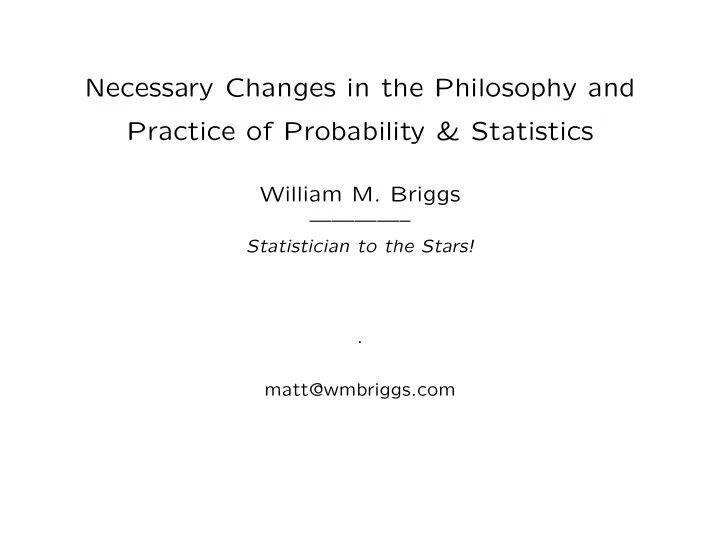

Necessary Changes in the Philosophy and Practice of Probability & Statistics William M. Briggs ————– Statistician to the Stars! . matt@wmbriggs.com
What is probability? All men are mortal Socrates is man Socrates is mortal
Just half of Martians are mor- tal Socrates is Martian Socrates is mortal
Pr(A) does not exist ! Pr(A | evidence) might exist A does not “have” a distribution Distributions do not exist
If Pr(A) = limiting relative frequency, then no probability can ever be known. If Pr(A | evidence) is subjective, then Pr( x = 7 | x + y = 12) = 1 if I say so .
Interocitors can take states s 1 , . . . , s p This is an interocitor This interocitor is in state s j Pr( s j | Interocitors can...) = 1 /p :: No sym- metry !
Jack said he saw a whole bunch of guys There were 12 guys Pr(12 | Jack said...) = not too unlikely .
Be cause Cause :: form + material + mechanism + direction :: essence + power Pr(Y | cause or determine) = 1 0 cos 2 θ ) − 1 · x 2 y = tan( θ ) · x − g (2 v 2 Pr( y | xgv o θ ) ∈ { 0 , 1 }
Chance or randomness are not ontic, thus powerless. No probability model is causal (in- cluding QM). Every potential must be made actual by something actual (including QM). We have Pr(Y | X), where X is that informa- tion we think or assume is probative of Y— meaning we think X is related to the causal path of Y. If not, pain .
Hypothesis testing? We cannot derive from Pr(Y | X) = p that Y. Probability is not deci- sion ! P-value = Pr(larger ad hoc stat | M Θ , x, θ s = 0), which is no way related to Pr( θ s = 0 | x, M Θ ). Pr(larger ad hoc stat | M Θ , x, θ s � = 0) may be lower!
Models Bayes is not important: probabaility is. A parameterized model M relates X to Y probabilistically, e.g. µ = β 0 + β 1 x where µ is central parameter of normal used to charac- terize uncertainty in some y . “Priors” a real distraction: start finite!
With rare exceptions, parameters are of no interest to man nor beast. Y = f (X , ˆ ˆ θ (M θ )) ignores uncertainty, and makes a decision. Pr( θ | data, M θ ) only about unobservable pa- rameters.
We want this: Pr(Y | new X, data, M), where the data are old values of Y and X, and M are the argu- ments that led to a (parameterized) model; the parameters having been integrated out. This—and only this—captures the full un- certainty, given M. Prediction!
Every model—neural net, statistical, machine learning, artificial intelligence, anything—can fit into the Pr(Y | XDM) schema. What dif- ferentiates them is usually a matter of ad hoc complexity and form—and a building in of decision.
Demystifying “learning” ANNs, GANs, Deep this-and-thats, etc. = parameterized non-linear regressions Learning = estimating parameters Extracting features = f (input data)
There is no such thing as unsupervised learn- ing. Every algorithm does exactly what it is de- signed to do , and therefore gives correct results— conditional on the algorithm. Not all probability is quantitative, and not all algorithms live in machines.
Monte Carlo — The place to lose your money, and your way. Jaynes: “It appears to be a quite general principle that, whenever there is a random- ized way of doing something, then there is a nonrandomized way that delivers better per- formance but requires more thought.”
Image D with possible signal + background Pr( d ij | MB) ∼ Poisson( λ B ) Pr( d ij | MS+B) ∼ Poisson( λ S + λ B ) Pr( d ij | MS+B , MB) = p P( λ B )+(1 − p )P( λ S + λ B ) Pr(MS+B | d ij ) Guglielmetti et al., 2002, Mon. Not. R. Astron. Soc
Roe et al.
Skill: Obs S B Mod S 3 5 B 5 87 Super machine neural deep-learning boosting forest machine boasts 90% accuracy! Skill and calibration curves, not ROC.
Model-based vs. verification-based uncertainty; verify “features”. All uncertainty carried through to the bitter end. In the absence of knowledge of cause, all probabilistic models will classify imperfectly.
“This is not not a statis- tics text, it is not a treatise on philosophy of science or logic. This work is like noth- ing I have seen before, an excellent combination of the above, indeed the ‘the soul of modeling, probability ...’, presented with passion and accessible to everybody.” “It is a deep philosophical treatment of probability writ- ten in a plain language and without the interference of unnecessary math.”
Recommend
More recommend